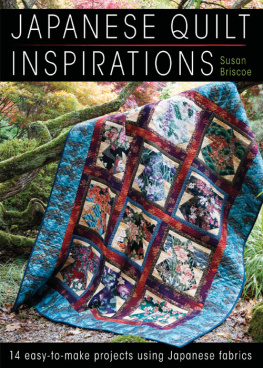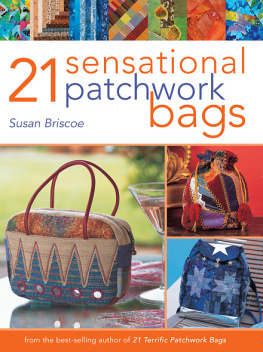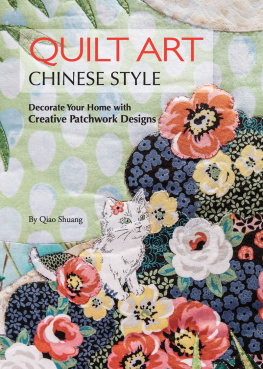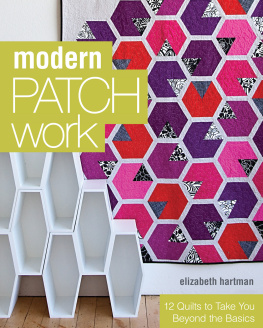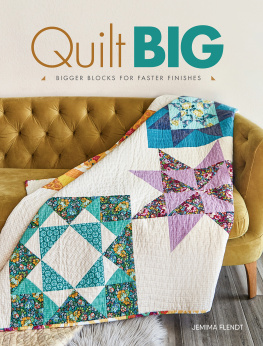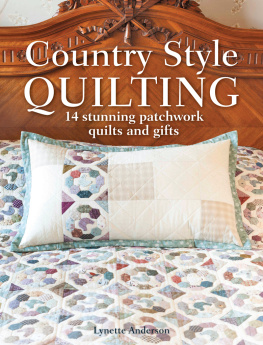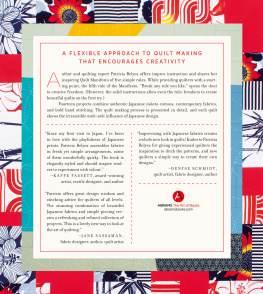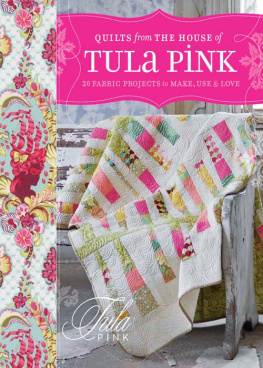Japanese Quilt Inspirations
Susan Briscoe
14 easy-to-make projects using Japanese fabrics


www.rucraft.co.uk

Introduction
Japanese fabrics appeal to quilters worldwide, who often seek a special quilt project to feature these gorgeous materials to their best advantage. Inspired by the imagery I found all around me when I lived in Japan, here are ten quilts and four smaller projects reflecting traditional Japanese patterns and motifs which will feature your Japanese fabrics in an authentic style. Designed to let the fabrics take centre stage, they use the easiest methods to obtain the maximum effect.
When I went to work in the north of Japan, in a small town called Yuza-machi in Yamagata Prefecture, I was inspired to begin quilting by the geometric designs I saw in traditional architecture, design and crafts. The subtle shades of the landscape, the unusual colour combinations in kimono ensembles, the tea ceremony and local festivals all were a treasure trove of ideas. Yamagata Prefecture is noted in Japan for its festivals and culture, shaped by its historical importance in trades such as benibana (safflower) cultivation and rice production. By chance I was in the ideal place to absorb some of the diverse visual language of this fascinating country. My experiences there continue to influence my quilts.
The quilts and projects I have created for you explore many fabric themes, from the blues and browns essential for Japanese country style to richly coloured gold prints and kimono silks evocative of sumptuous treasures. There are quilts for large scale feature panels () offer more ideas. Blocks from the quilts are used in different ways to make four smaller projects, which can be treated as block tasters or as ways to use up spare patchwork from the quilts.
In addition to ideas for working with traditional Japanese fabrics, such as cotton yukata and silk kimono cloth, the patchwork explores the use of Japanese-themed strip cuts, fat quarters and other specially created collections, including large, printed feature panels. The quilts are not dependent on having exactly the same prints and six designs are presented twice in different fabric themes, suggesting other creative and quilting options. There are instructions for the easy patchwork and appliqu methods used. Ideas for hand and machine quilting are provided, including sashiko-style big stitch quilting. Ten of the quilts showcase professional machine quilting on long-arm machines see for details offering the ideal finishing solution if you dont want to quilt a large piece yourself.
It all starts with the fabrics
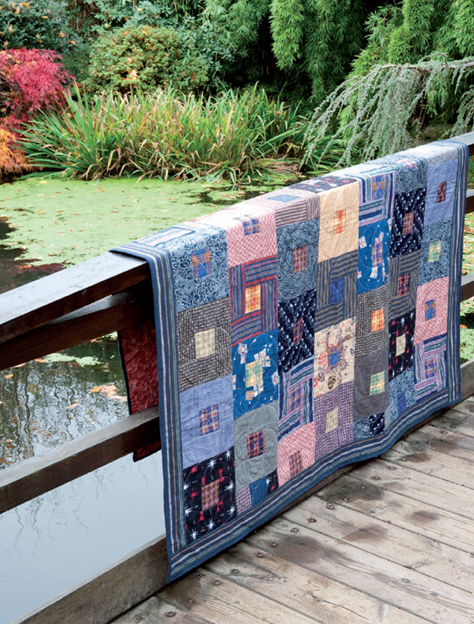
Fabrics
Japanese fabrics, made in Japan, and Japanese style fabrics, produced outside of Japan, can be combined successfully to make beautiful, unique quilts. Whether your taste is for the bright hues of childrens kimono, the shades of Japanese maples in autumn, the fresh blue and white of cotton yukata kimono or the blues and browns of country fabrics, you can use these in your quilts. A selection of fabric suppliers is listed .
Old and New Fabrics
Because 100% cotton can be pressed to give a crisp seam, it is the easiest to use for patchwork and appliqu. Many traditional Japanese fabrics are reproduced as cotton prints, some with dobby or sateen weaves for textural interest. Patterns range from tiny designs to large-scale patterns, which can be used together and are frequently produced as a complete collection for patchwork, like the majority of the fabrics used for the . American cotton stripes and checks blend in well for the Japanese country look, although the dark blue may be more ultramarine than indigo. Faux patchwork fabrics reflect the Japanese traditions of boromono (rag cloth patchwork) and, on a more sophisticated level, shikishi (poem card motifs) are often shown overlapped.
Traditional Japanese fabrics for kimono are narrow width, approximately 1414in (36.2cm). These may be silk, cotton, wool or various blends. Cotton fabrics with woven patterns suitable for patchwork include shima (stripes), koshi (checks), kasuri (ikat) and tsumugi (a slubbed weave). Fabrics salvaged from damaged kimono are often used for patchwork by Japanese quilters, but think twice before cutting up an old kimono for patchwork yourself you may have an interesting antique, and vintage kimono are a finite source of patchwork material. Old fabrics may also be weak. Soft, recycled kimono silks, like chirimen (crpe) can be backed with a lightweight iron-on interfacing for patchwork. Cottons are easier to sew but silk can add a special glow to a quilt, like the autumnal tones used for . Tsumugi is woven in silk as well as cotton and was used for the chequerboard blocks in the same quilt.
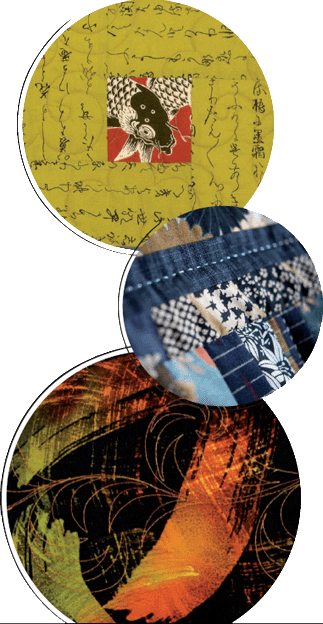
Japanese-style patchwork prints, reproduction traditional fabrics and kimono silks include different textures, from glossy to homespun weaves.
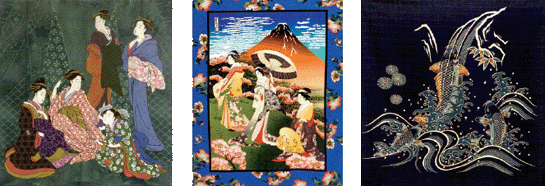
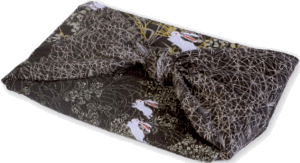
) are intended for wrapping goods and gifts but their bold pictorial designs make great quilt panels. Similar large designs are printed as quilt panels, as shown here.
Dyed patterns include large and small motifs. Freehand yuzen rice paste-resist dyeing, invented around 1700, is used for formal silk kimono, sometimes with silk or gold embroidery. These designs are frequently reproduced in quilting fabrics, with the gold accents added in a metallic print, such as the floral designs used for . Komon (small patterns) are smaller designs, with tiny edo komon patterns stencilled in just two colours, similar to tone-on-tone patchwork fabric.
Trusted Tip
Generous fabric quantities are given in the You Will need list for each project, but if you wish to select a particular motif (fussy cutting) or want to use a directional fabric in your quilt, it is advisable to add a little more.
Katazome, large-scale stencilled fabric, usually indigo and white, used to be made for household textiles, such as futon covers, and is now reproduced for quilting. Patchwork prints of shibori (tie dye) and kasuri (ikat) recreate affordable copies of expensive fabrics. Contemporary stencil-dyed cottons, like yukata fabrics for summer casual kimono, usually have large patterns, ideal for featuring in the fan appliqus in the .
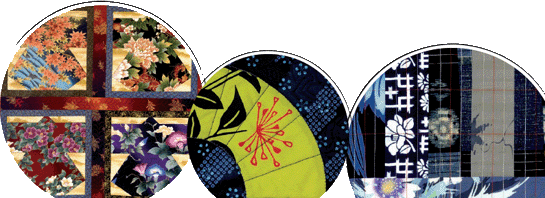
Gold metallic prints in rich colours, bright contemporary yukata cottons and traditional indigo fabrics can be combined in your quilts for unique results.

